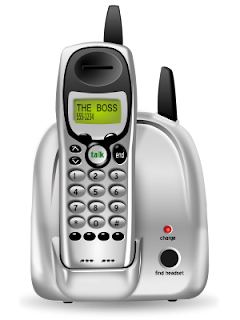They're pretty much ubiquitous in every home and office now. Like the mobile phone, the cordless telephone was considered the height of hi-tech sophistication in the 1980s, but nowadays it is increasingly unlikely to find a landline with a handset constrained by a cord. Like many of the household items we take for granted, however, most of us rarely stop to consider how our cordless phones actually work. Here's a brief guide to the technology behind the rise of the cordless phone.
The key lies in the radio link
In a nutshell, the reason a cordless telephone handset is able to roam free is down to the radio link that connects it to its base unit. The base unit itself operates pretty much as an old-fashioned landline telephone always did, connected directly to the network of phone lines via your wall-mounted telecoms socket. The handset, however, communicates with the base station via radio waves with a short range – typically only a couple of hundred metres from the base station, so it is not possible to use the handset much beyond one's house or yard.
Cordless phone origins and all that jazz
The basic concept behind the cordless telephone was devised by jazz musician Teri Pall. Ms Pall patented the design for a cordless phone in 1965, but sadly the two-mile range of the radio waves interfered with aircraft communications, which meant the patent failed to be marketed and she sold the rights to it in 1968 to a manufacturer who "dumbed it down” by reducing its range and making it more suitable for domestic use. At around the same time, amateur radio operator and inventor George Sweigert was working on a similar idea, filing his own patent in 1966. His patent was for a "full duplex wireless communications apparatus" and today's cordless phones are mainly built on this initial idea.
Power required
Another major difference between a cordless phone and a corded telephone is the power requirement. Old-fashioned phones merely needed to be connected to the phone network to function, and during a power cut would usually continue to operate. A cordless phone's base station requires electricity to power it – not only because it needs to keep the handset charged, but also because radio transmissions require a power source, and the myriad of additional features which cordless phones offer also need to be electronically co-ordinated.
Constant technological refinement
The digital revolution has led to cordless phone technology coming on in leaps and bounds. The first digital cordless phones were introduced in 1994, making the signal clearer and harder to eavesdrop on. The next year, digital spread spectrum (DSS) was introduced, making eavesdropping harder still – and now all good cordless phones are operating standard protocols such as the Personal Handy-phone System (PHS) and Digital Enhanced Cordless Telecommunications (DECT), making their versatility and functionality closer to mobile phones than ever before.




 TechQuark is a mobile-friendly website. Simply bookmark
TechQuark is a mobile-friendly website. Simply bookmark 